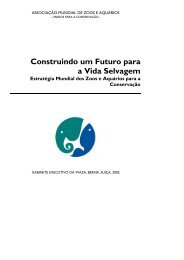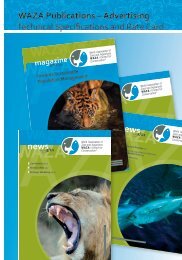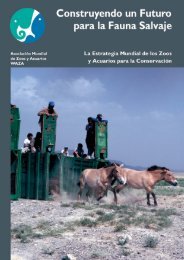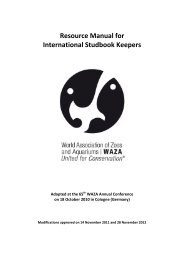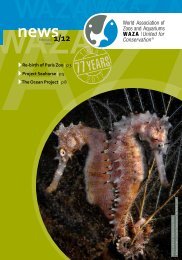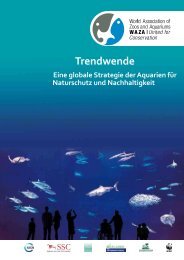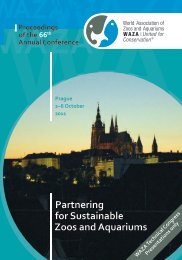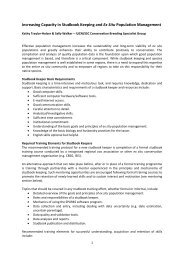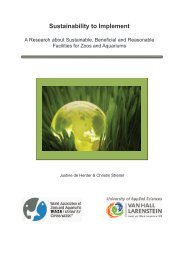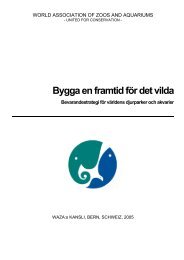Towards Sustainable Population Management - Waza
Towards Sustainable Population Management - Waza
Towards Sustainable Population Management - Waza
You also want an ePaper? Increase the reach of your titles
YUMPU automatically turns print PDFs into web optimized ePapers that Google loves.
WAZA magazine Vol 12/2011<br />
Fig. 1<br />
Intersections of biodiversity conservation, ex situ zoological and botanical institutions and<br />
intensive management of populations, with examples of the activities that fall within each region.<br />
The centre of overlap between all three circles are those ex situ populations that are being<br />
managed intensively to help achieve their conservation. That region plus the intensively<br />
managed wild populations constitutes the focus of the discussions<br />
on the use of IMPs for conservation.<br />
Working groups tackled aspects of<br />
intensive population management for<br />
species conservation, from identifying<br />
priority species for management<br />
to improving management effectiveness<br />
and increasing collaboration.<br />
The following goal encapsulates<br />
much of what participants believe<br />
zoos need to achieve: The world<br />
zoo and aquarium communities are,<br />
and are acknowledged as, effective<br />
conservation partners in the context of<br />
integrated conservation strategies that<br />
include intensive population management.<br />
To work towards this goal, we must:<br />
• Change the current paradigm of<br />
the ways zoos contribute to species<br />
conservation by committing to<br />
conservation missions and adopting<br />
appropriate business models to<br />
achieve this.<br />
• Incorporate IMPs as potential<br />
effective conservation tools into<br />
holistic species conservation strategies,<br />
increase collaboration with<br />
conservation partners and improve<br />
understanding of the role of IMPs in<br />
conservation.<br />
• Improve the viability and success of<br />
long-term IMP programmes, ensuring<br />
that each species has a precise<br />
and appropriate management plan<br />
and adequate resources to achieve<br />
its roles.<br />
• Improve the success of species conservation<br />
programmes by optimally<br />
utilising populations along a management<br />
continuum, including exploration<br />
of alternative approaches<br />
to population management and<br />
expanding metapopulation strategies<br />
for managing multiple populations<br />
effectively.<br />
Intensively Managed <strong>Population</strong>s<br />
The Challenges<br />
Regional zoo associations coordinate<br />
the collaborative management of<br />
about 800 species, in programmes<br />
such as the Species Survival Plan<br />
(SSP) of the Association of Zoos and<br />
Aquariums (AZA) in North America,<br />
the European Endangered Species<br />
Programme (EEP) of the European<br />
Association of Zoos and Aquaria<br />
(EAZA), the Australasian Species<br />
<strong>Management</strong> Program (ASMP) of the<br />
Zoo and Aquarium Association (ZAA)<br />
Australasia, and others. Often, however,<br />
these populations are managed<br />
in isolation and ex situ efforts often<br />
are not integrated with in situ conservation<br />
needs or activities, even for<br />
endangered species. Although we in<br />
the zoo community have convinced<br />
ourselves, our staff and our public<br />
that our managed programmes<br />
serve important conservation roles<br />
for those species, rarely can this be<br />
documented to be the case.<br />
<strong>Population</strong> goals for managed<br />
taxa are usually defined in terms of<br />
genetics and demographics, rather<br />
than in terms of supporting species<br />
conservation. Even given these<br />
limited goals, most managed zoo<br />
populations are not sustainable.<br />
Recent analyses (Baker 2007; Lees &<br />
Wilcken 2009) and data presented<br />
at the IMP workshop showed that<br />
most of these populations are not<br />
currently being managed at the<br />
numbers of individuals, reliability and<br />
predictability of reproduction and<br />
levels of genetic diversity that would<br />
be required to assure that they can<br />
contribute to species conservation.<br />
Rather than managing for conservation,<br />
the majority of programmes are<br />
managing for “acceptable” levels of<br />
decay and loss, instead of for truly<br />
sustainable, resilient and adaptable<br />
populations that will be available and<br />
suitable to serve conservation needs<br />
in the future. Not surprisingly, some<br />
colleagues within the conservation<br />
and scientific community do not see<br />
the conservation value of intensively<br />
managed ex situ populations.<br />
41<br />
»



